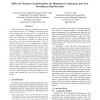Free Online Productivity Tools
i2Speak
i2Symbol
i2OCR
iTex2Img
iWeb2Print
iWeb2Shot
i2Type
iPdf2Split
iPdf2Merge
i2Bopomofo
i2Arabic
i2Style
i2Image
i2PDF
iLatex2Rtf
Sci2ools
104
click to vote
CVPR
2004
IEEE
2004
IEEE
Effect of Colorspace Transformation, the Illuminance Component, and Color Modeling on Skin Detection
Skin detection is an important preliminary process in human motion analysis. It is commonly performed in three steps: transforming the pixel color to a non-RGB colorspace, dropping the illuminance component of skin color, and classifying by modeling the skin color distribution. In this paper, we evaluate the effect of these three steps on the skin detection performance. The importance of this study is a new comprehensive colorspace and color modeling testing methodology that would allow for making the best choices for skin detection. Combinations of nine colorspaces, the presence of the absence of the illuminance component, and the two color modeling approaches are compared. The performance is measured by using a receiver operating characteristic (ROC) curve on a large dataset of 805 images with manual ground truth. The results reveal that (1) colorspace transformations can improve performance in certain instances, (2) the absence of the illuminance component decreases performance, an...
Color Modeling Approaches | Color Modeling Testing | Computer Vision | CVPR 2004 | Skin Color Distribution | Skin Color Modeling | Skin Detection Performance |
Related Content
| Added | 12 Oct 2009 |
| Updated | 12 Oct 2009 |
| Type | Conference |
| Year | 2004 |
| Where | CVPR |
| Authors | Sriram Jayaram, Stephen Schmugge, Min C. Shin, Leonid V. Tsap |
Comments (0)

